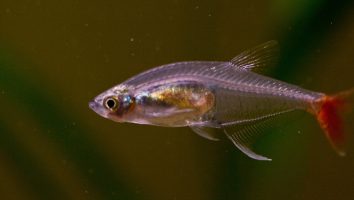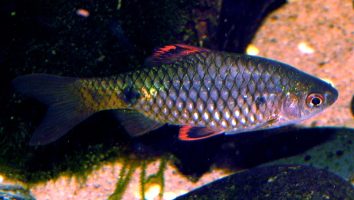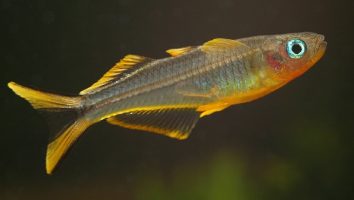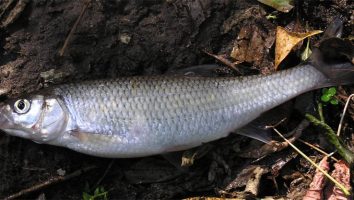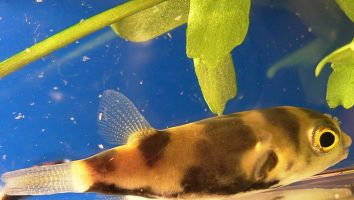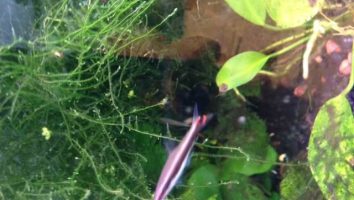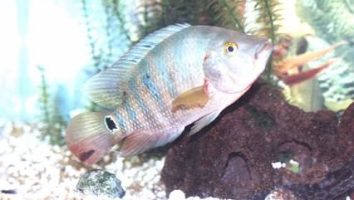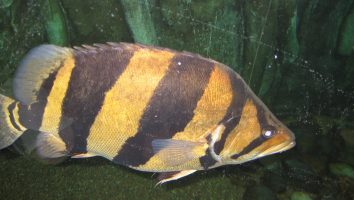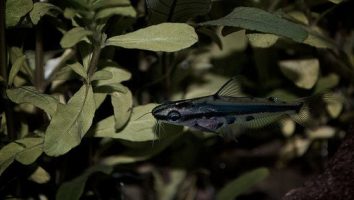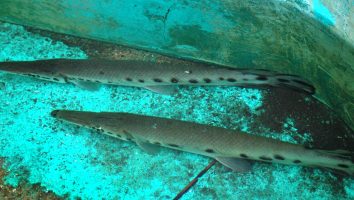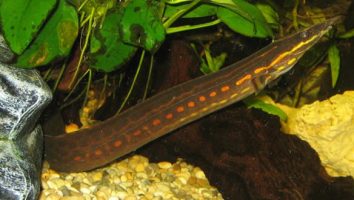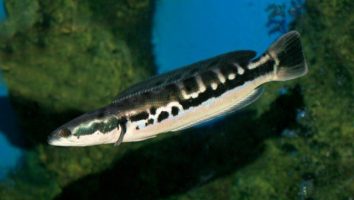The bumblebee cichlid is a beautiful freshwater fish that is perfect for beginner aquarists. They are easy to care for and are very peaceful, making them a great addition to any community tank.
This guide will teach you everything you need to know about bumblebee cichlid care. You’ll learn about their diet, size, lifespan, and more!
Table of contents
Species overview
The bumblebee cichlid (scientific name: Pseudotropheus barlowi) is a freshwater fish that’s native to Lake Malawi in Africa.
They’re called bumblebee cichlids because of their black and yellow stripes, which are reminiscent of the insect.
This is a fairly large fish when fully grown, so you’ll need a fairly large tank to accommodate them. They’re also known to be quite aggressive, so you’ll need to be careful about what other fish you put in with them.
Bumblebee cichlids are omnivores, so they’ll eat just about anything. In the wild, their diet consists of small insects, crustaceans, and other small invertebrates.
These fish are quite popular in the aquarium trade, so you should have no trouble finding them.
Appearance
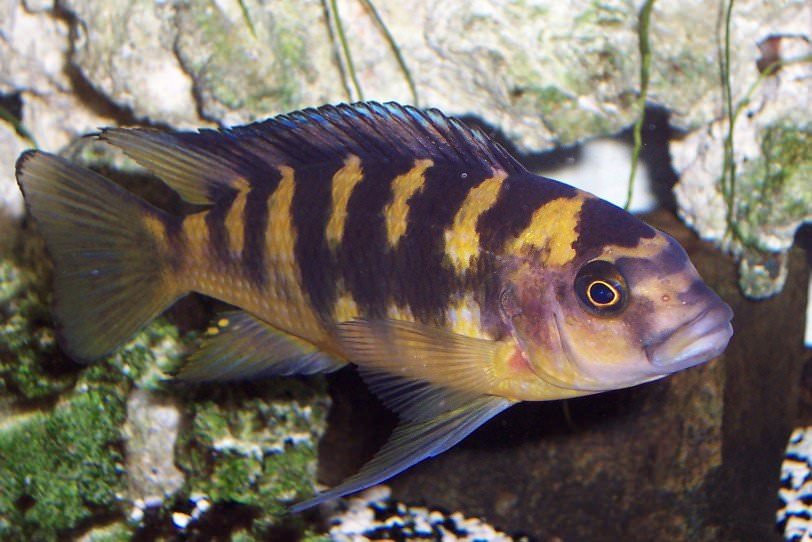
The Bumblebee cichlid is a beautiful fish that is easily recognizable thanks to their unique coloration. As you can probably guess from their name, these fish are yellow and black like a bumblebee.
The base color of these fish is a deep yellow. This color covers their entire body including their fins (with the exception of their dorsal fin).
The Bumblebee cichlid has a black stripe that runs from the tip of their nose all the way to the end of their tail. This stripe is quite thin and is bordered by a yellow line on each side.
This combination of colors makes for a very striking fish that is sure to stand out in any aquarium.
These cichlids are on the smaller side, only reaching about 4 inches at most. They have a fairly slender body shape that tapers off towards the end.
The Bumblebee cichlid has a dorsal fin that starts about two-thirds of the way back on their body. This fin is tall and thin with a pointed tip.
Their anal and pectoral fins are both short and relatively small. The caudal fin is forked and symmetrical.
Lifespan
In the wild, bumblebee cichlids typically have a lifespan of 3 to 5 years. However, in captivity, they can live up to 10 years with proper care.
As with all animals, there are a number of factors that can impact the lifespan of a bumblebee cichlid. In the wild, predation and disease are the two biggest threats to these fish.
In captivity, the biggest threats to bumblebee cichlids are poor water quality and stress. These fish are very sensitive to changes in their environment and can be easily stressed out by things like loud noises or bright lights.
Size
The Bumblebee cichlid’s maximum size is about 4 inches.
Tank
Tank Size
The minimum tank size for a single bumblebee cichlid is 30 gallons. If you want to keep more than one fish, you should add at least another 20 gallons for each additional fish.
These cichlids are relatively peaceful fish but they can be aggressive towards their own species if they don’t have enough space. If you want to keep more than one bumblebee cichlid, we recommend a tank size of at least 50 gallons.
Water Parameters
The bumblebee cichlid is a freshwater fish that is native to Africa. In the wild, they are found in the rivers and lakes of the Congo Basin.
The recommended water parameters for bumblebee cichlids are:
- Water temperature: 75 to 82 degrees Fahrenheit
- pH levels: 6.8 to 7.6
- Water hardness: 5 to 15 dGH
- Alkalinity Levels: 4-8 dKH
What To Put In Their Tank
Bumblebee cichlids are one of the more popular freshwater fish because of their vibrant colors and fun personality. They’re also a pretty easy species to care for which is great for beginners.
When it comes to setting up their tank there are a few things you’ll need to take into consideration.
The first is the substrate. These fish like to dig so you’ll want something on the softer side (sand is a good choice). Avoid anything too sharp or jagged since it could hurt their delicate fins.
Next, you’ll need to add some hiding places. Rocks, caves, and driftwood are all great options. These fish like to have a place to hide when they feel threatened or want to rest.
You can also add some plants to their tank if you want. Just be aware that they might nibble on them from time to time. Hornwort, Java Moss, and Water Wisteria are all good choices.
Finally, make sure you include a good filter. Bumblebee cichlids are pretty messy eaters so you’ll need something that can keep up with the waste they produce.
Common Diseases
The Bumblebee cichlid is a hardy fish that doesn’t get sick often. However, like all other animals, they are still susceptible to disease.
The most common illness that these fish experience is ich. This is a parasite that can cause a lot of problems if it’s not dealt with quickly.
The most obvious sign of ich is the presence of white spots on the body of your fish. If you notice this, it’s important to act fast.
There are many different ways to treat ich, but the most important thing is to do something as quickly as possible. The longer you wait, the more chance there is that your fish won’t make it.
Another disease that these fish can get is hole-in-the-head. This is another water quality related illness that is caused by poor living conditions.
The most obvious symptom of this disease is, you guessed it, holes in the head of your fish. These holes can range in size from very small to quite large.
If you notice this disease in your fish, the best thing to do is to improve the water quality in their tank. This will usually be enough to get rid of the disease. However, if the holes are large, you may need to consult a vet.
Behavior & Temperament
Bumblebee cichlids are one of the more aggressive species on our list. They are known to be territorial and will defend their space from anyone who tries to enter it. This includes other fish, plants, and even inanimate objects.
The good news is that they are only aggressive towards their own kind. So, if you have other fish in your tank, you don’t have to worry about them being attacked.
Bumblebee cichlids are also known to be very active. They are constantly swimming around the tank and exploring their environment. This is one of the reasons why they need a lot of space. If they don’t have enough room to swim, they can get stressed out and become even more aggressive.
Tank Mates
Bumblebee cichlids are semi-aggressive and should only be kept with other semi-aggressive or aggressive fish. They are not a good choice for a community tank.
Some compatible tank mates for bumblebee cichlids include:
- Other bumblebee cichlids
- Convict cichlids
- Firemouth cichlids
- Jack Dempsey cichlids
- Oscar cichlids
- Green terror cichlids
- Blood parrot cichlids
Breeding
The Bumblebee Cichlid is a beautiful and popular fish that is easy to breed in the home aquarium. They are egg-layers and mouthbrooders, meaning that the female will lay the eggs and the male will fertilize them. The female will then mouthbrood the eggs until they hatch.
To start the breeding process, you will need to set up a breeding tank. The tank should be at least 30 gallons and should have plenty of hiding places. You will also need to add some plants to the tank. The plants will help to keep the water quality high and will provide places for the fry to hide.
When setting up the breeding tank, it is important to use water that is the same temperature and pH as the water in the main tank. This will help to reduce stress on the fish and will make the transition to the new tank easier.
Once the breeding tank is set up, you will need to add a pair of Bumblebee Cichlids to the tank. It is best to add one male and one female. The male will be larger than the female and will have longer fins.
The Bumblebee Cichlid is a peaceful fish, but the male can be aggressive during spawning. For this reason, it is best to add the female to the tank first. This will give her a chance to acclimate to the new tank and to find a hiding place.
Once the female is acclimated, you can add the male to the tank. It is best to add the male at night, as this will help to reduce stress on the fish.
Once the pair is in the breeding tank, they will start to spawn. The female will lay a large number of eggs on a flat surface. The male will then fertilize the eggs.
Once the eggs are fertilized, the female will mouthbrood them. The fry will hatch in about two weeks. The female will then mouthbrood the fry for another two weeks.
Once the fry are free-swimming, they can be fed baby brine shrimp. The fry will grow quickly and will be ready to be moved to the main tank in about two months.
Conclusion
Bumblebee cichlids are an awesome fish for anyone who wants to add a little bit of personality to their tank. They’re fun to watch and their colors are absolutely stunning.
They do have some specific care requirements that you’ll need to be aware of, but as long as you’re willing to put in the effort, we think you’ll be very happy with these fish.
Overall, we think they’re a great option for anyone who’s looking for something a little different in their tank.

